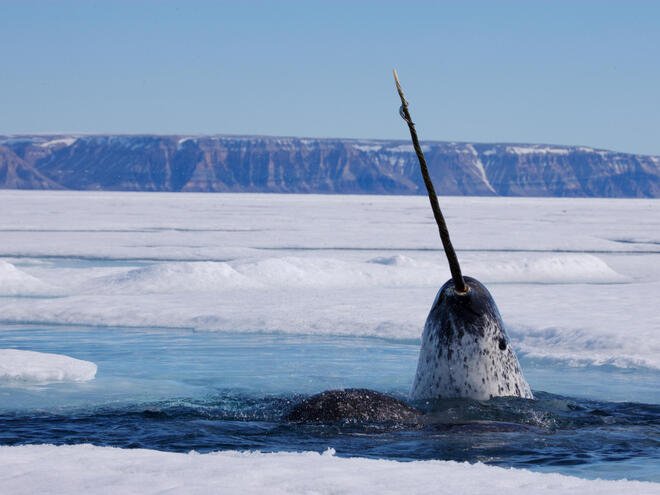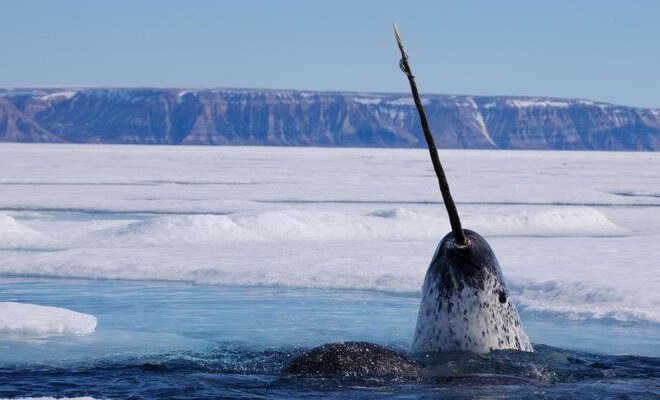
Narwhals are primarily found in the Atlantic and Arctic Oceans, but their range is more specific than just “the ocean.” They thrive in cold, deep waters, often near ice-covered regions. Imagine walking through a quiet, snowy forest; each step you take reveals a hidden world. Similarly, venture into the depths of the ocean, and you’ll discover the delicate balance of life there’s—an intricate web that narwhals are an essential part of. Let’s dive into their habitats and see where these incredible animals are found.
Understanding Narwhal Habitats
So, what exactly constitutes a narwhal’s habitat? It’s not just about where they swim; it’s about the conditions and resources around them. Narwhals love cold, Arctic waters, where they can feed, breed, and find safety from predators. These waters are usually filled with ice, which is both a challenge and a haven for them.
Their primary feeding areas are often located in the deep offshore waters of Greenland and Canada. This is where narwhals dive deep to hunt for fish, squid, and shrimp. The cold waters keep their prey plentiful, allowing them to thrive. So, imagine a gourmet restaurant where every dish is just a dive away; that’s the type of environment narwhals enjoy!
Moreover, narwhals are quite social. During the summer months, they can form groups—or pods—of up to 20 individuals. Being in a pod offers safety in numbers, especially when navigating through icy waters filled with potential threats. Here’s the thing: these friendships are not just for fun; they play a vital role in survival.
The Role of Ice in Narwhal Habitats
Now, let’s talk about ice. It’s more than just a chilly backdrop; it’s crucial for narwhals. They prefer areas with stable ice pads that allow them to rest and breathe. These ice formations create holes known as “leads,” which give narwhals access to the surface for air.
In the winter months, narwhals often end up in ice-covered regions, relying on thinner layers of ice to breathe. Picture a pool party with only a few floaties; you have to be strategic about where you lean. Narwhals do something similar—they navigate through leads to survive. Furthermore, these whales filter their breathing holes to keep them open, demonstrating their adaptability.
While it’s fascinating to think about, climate change is affecting these habitats. As ice melts and alters, narwhals may find it challenging to adapt. This brings us to a pressing concern: how are these changes affecting not just narwhals, but the entire ecosystem they inhabit?
Where Do Narwhals Migrate?
Migration is integral to a narwhal’s life. Let me explain: during different seasons, narwhals travel between various habitats based on food availability and water conditions. In the summer, they move to shallower bays and fjords, while in winter, they head out to deeper waters where ice covers the surface.
This migratory pattern isn’t random; it’s all about survival. During summer, when food is abundant, narwhals feast on fish and squid close to the surface. As winter approaches, they migrate to deeper waters where they can dive to hunt more efficiently. Imagine packing up your favorite snacks for a road trip— narwhals do something similar by following food around the oceans.
Interestingly, narwhals have been known to travel up to 1,000 miles during their seasonal migrations. This journey isn’t just a casual stroll; it takes them through various oceanic landscapes, where they face challenges and discover new feeding opportunities.
Distinct Habitats: Coastal vs. Open Ocean
Narwhals have different preferences when it comes to their habitats. There are primarily two types: coastal habitats and open ocean habitats. Each presents its own unique advantages and disadvantages.
In coastal habitats, narwhals benefit from rich feeding grounds teeming with fish and invertebrates. The shallow waters often provide a safer environment with fewer predators, making it easier for young narwhals to thrive. Picture a bustling market where everything you need is just around the corner; that’s how narwhals experience coastal areas.
On the flip side, open ocean habitats offer access to deep waters filled with nutrient-rich currents, perfect for hunting. However, they also expose narwhals to larger predators like orcas. It’s like choosing between a cozy home with all your friends nearby or a big, open field where the thrill of adventure awaits but comes with risks.
Knowing where narwhals prefer to hang out helps scientists understand how to protect them. Preserving critical habitats and migration routes is vital for their survival—just like ensuring a safe playground for kids.
The Impact of Climate Change on Narwhals
Climate change is one of the biggest challenges facing narwhals today. As the Earth gets warmer, the Arctic ice they depend on is melting faster than ever. This loss of ice affects their entire ecosystem.
Imagine a jigsaw puzzle where pieces are missing; it’s hard to see the full picture. Similarly, as ice disappears, narwhals face challenges in finding safe breathing holes and adequate food sources. Changing ocean temperatures can also alter prey distribution, forcing narwhals to adapt rapidly.
Moreover, increased shipping traffic and oil exploration in the Arctic create disturbances in their habitats. Not only do these activities pose direct threats, but they also increase noise levels that can disrupt communication among narwhals.
Protecting narwhals requires urgent action. Implementing conservation efforts and reducing carbon emissions can help preserve their habitats and ensure they continue to thrive. It’s a community effort, reminding us that every action counts—like a ripple effect.
Conservation Efforts for Narwhals
With all these challenges in mind, let’s talk about what’s being done to protect narwhals. Conservation efforts are underway to address the issues they face. Organizations and governments are working together to monitor narwhal populations and their habitats closely.
One promising initiative is the creation of marine protected areas (MPAs) in crucial narwhal habitats. These zones are designated to limit human activities and provide safe spaces for narwhals and their prey to thrive. It’s like building a safe harbor where kids can play freely without worry—essential for healthy growth.
Additionally, researchers are studying narwhal migration patterns and behaviors. By tracking their movements, scientists can gather valuable data to inform conservation policies. This knowledge helps pinpoint vital areas that need protection, ensuring narwhals can continue to navigate their icy realms safely.
You might be wondering how you can help. Supporting marine conservation organizations or advocating for sustainable practices can contribute to the larger mission of protecting narwhals and their habitats. Remember, every effort counts!
Final Thoughts: Narwhals and Their Future
In conclusion, narwhals are remarkable creatures that inhabit unique and breathtaking environments within the Arctic and Atlantic Oceans. Understanding where narwhals are found not only highlights their extraordinary lives but also emphasizes the critical need for conservation efforts to protect their habitats from the effects of climate change.
As we continue to learn about these remarkable marine mammals, let’s remember that their survival is intertwined with the health of our oceans. Protecting narwhals means protecting an entire ecosystem and preserving the magic of the Arctic. So, the next time you hear about narwhals, you’ll know just how vital their homes are, and what we can do to help ensure they stick around for generations to come.

